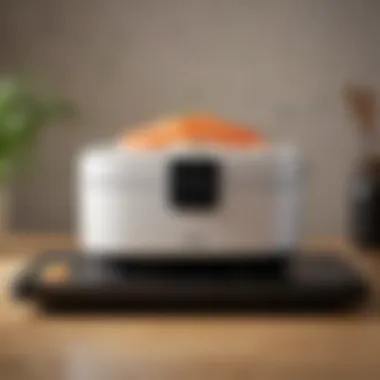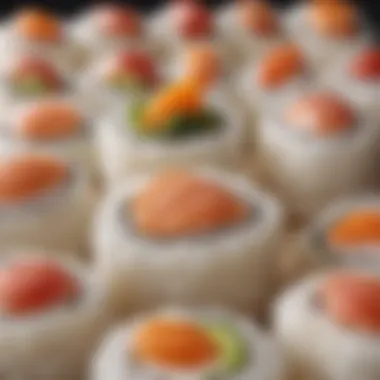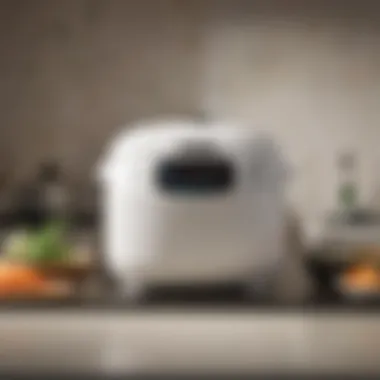The Ultimate Guide to Choosing Sushi Rice Cookers


Intro
Sushi rice cookers are specialized kitchen appliances that play a vital role in preparing sushi rice, making them a key component in the art of sushi making. This guide aims to provide detailed insights on sushi rice cookers, highlighting their importance, types, features, and common misconceptions. By understanding these elements, both novices and experienced cooks can elevate their sushi making skills.
Importance of Sushi Rice Cookers
The sushi rice cooker streamlines the process of cooking rice to achieve the perfect texture and flavor essential for sushi. Unlike traditional rice cookers, these machines often include features designed specifically for sushi rice. Mastering the technique of cooking sushi rice can greatly enhance the overall quality of the sushi you create.
Overview of Types
When considering sushi rice cookers, it’s essential to know that they come in various designs and functionalities. Some popular types include:
- Electric sushi rice cookers: These provide automated cooking with settings specific to sushi rice.
- Multi-cookers: These appliances often come with a range of cooking settings including rice, porridge, and more.
- Stovetop rice cookers: These are simpler pots that require manual monitoring during the cooking process.
Each type offers distinct advantages, and choosing the right one depends on individual preferences and cooking styles.
Key Features to Consider
When selecting a sushi rice cooker, several features should be taken into account:
- Capacity: Consider how much rice you typically need to prepare at once.
- Settings and Functions: Look for dedicated sushi rice settings for optimal results.
- Keep Warm Function: This feature helps maintain rice at a serving temperature without overcooking.
- Ease of Cleaning: Non-stick interiors help with easy maintenance.
By understanding these features, you can make an informed choice that meets your cooking needs.
Common Misconceptions
Many believe that any rice cooker can achieve perfect sushi rice. In reality, sushi rice requires specific cooking methods to attain its unique texture. Furthermore, some may think washing rice is unnecessary—this is critical since it removes excess starch, resulting in better texture and flavor.
Maintaining Your Sushi Rice Cooker
Proper maintenance is essential for longevity and optimal performance. Regularly clean the inner pot and steam vent to prevent food residue buildup. Following the manufacturer's recommendations can ensure that your appliance serves you well for many years.
Intro to Sushi Rice Cookers
In the journey of mastering sushi, understanding the tools and techniques is essential. Sushi rice cookers stand as one of the most crucial appliances in achieving the perfect texture and flavor of sushi rice. They simplify the process, making it accessible not only for seasoned chefs but also for home cooks wanting to replicate authentic tastes.
The importance of sushi rice cookers lies in their ability to deliver consistent results. Traditional methods can often lead to varying outcomes, while a dedicated rice cooker provides precise temperature control and timing. This article unveils the different types of sushi rice cookers, their unique features, and how they contribute to the sushi-making process.
In addition to detailing the technical specifications, we will illustrate how using the right rice cooker elevates not just the quality of rice, but the overall dining experience. The invaluable role these appliances play in modern kitchens cannot be understated, paving the way for culinary creativity and precision.
Understanding Sushi Rice
Sushi rice is distinct, characterized by its sticky texture and a naturally sweet flavor. It is crucial to choose the right type of rice for sushi preparation. Short-grain Japanese rice, such as Koshihikari, is typically preferred. Its ability to clump together when cooked is what makes it ideal for sushi. The quality of the rice impacts not only the texture but also the overall flavor of the sushi.
Understanding the characteristics of sushi rice includes its gluten content and how it absorbs water. The rice must be rinsed thoroughly before cooking to remove excess starch, allowing for a more desirable texture. Every step taken toward preparing sushi rice sets the foundation for a satisfying dish.
The Role of Rice Cookers in Sushi Preparation
Rice cookers play an integral role in sushi rice preparation. Unlike standard cooking pots, these cookers are designed specifically for rice, offering various functions tailored to different rice types. Some advanced models come with settings for porridge, brown rice, and sushi rice, allowing for precise cooking adjustments.
A sushi rice cooker automates the cooking process, reducing the likelihood of human error. This feature is especially beneficial for those who are still mastering the art of sushi making. Moreover, many cookers include a steaming function that allows for additional vegetables or fish to be cooked simultaneously, enhancing the flavor palette of the dishes prepared.
By having the right rice cooker, culinary enthusiasts can ensure that each batch of sushi rice is cooked perfectly, laying the groundwork for great sushi. This equipment ensures that home cooks can focus more on crafting beautiful sushi rolls rather than worrying about the intricacies of cooking rice. Thus, investing in a quality sushi rice cooker is essential for anyone serious about sushi.
Types of Sushi Rice Cookers


When selecting a sushi rice cooker, understanding the various types available is crucial. Each type possesses unique characteristics that can significantly affect the outcome of your sushi rice. This part of the article delves into the different types of sushi rice cookers, highlighting their specific elements, benefits, and considerations.
Traditional Electric Rice Cookers
Traditional electric rice cookers are perhaps the most accessible and widely used type. These cookers are designed with simplicity in mind. The fundamental operation involves a cooking bowl and a heating element. When using a traditional electric rice cooker, it’s important to follow the manufacturer’s instructions for optimal results.
The main benefits of these cookers include:
- Ease of use: Most traditional models require minimal input. Just add rice and water, plug in, and let it cook.
- Affordability: They are generally less expensive compared to more advanced options.
- Versatility: Besides sushi rice, they can cook other rice types or grains.
However, there are considerations to take into account. Traditional electric cookers may not offer the precision needed for perfect sushi rice texture. Moreover, the cooking mechanism may result in uneven cooking if the cooker is not calibrated correctly. This can affect each grain’s integrity, which is essential for sushi preparation.
Pressure Rice Cookers
Pressure rice cookers have gained popularity among serious cooks. They utilize steam pressure to expedite the cooking process and retain moisture effectively. This type offers several advantages when preparing sushi rice:
- Rapid cooking time: The high-pressure environment cooks rice quicker than traditional methods.
- Moisture retention: Rice cooked under pressure tends to be more hydrated, yielding fluffier and stickier grains.
While the advantages are significant, there are also challenges. Pressure rice cookers often are more expensive and complex. Understanding how to operate them can take some practice. Additionally, setting the right cooking time and water ratio is vital to avoid overcooking or undercooking the rice, which can hinder the sushi-making experience.
Induction Heating Rice Cookers
Induction heating rice cookers represent the most advanced technology in rice cooking. These models provide precision heating by using electromagnetic induction to cook rice evenly from all angles. The following are notable benefits:
- Consistent results: Induction heating allows the temperature to be monitored and adjusted throughout the cooking process, ensuring even cooking.
- Programmable settings: Many models come with various settings for different rice types and even other dishes, allowing versatility in the kitchen.
However, potential buyers should note that:
- Higher cost: Induction heating rice cookers are typically more expensive than traditional cookers.
- Power requirements: They often require more electrical power and may not be compatible with every kitchen's setup.
In summary, each type of sushi rice cooker has unique attributes that cater to different preferences and requirements. Understanding these differences can help you make an informed decision, ultimately enhancing your sushi-making journey.
Key Features to Consider
When selecting a sushi rice cooker, several key features should be considered to ensure proper cooking performance and user satisfaction. Understanding these features can significantly influence the quality of your sushi rice and your overall cooking experience.
Capacity and Size
Capacity and size are crucial when choosing a sushi rice cooker. These factors dictate how much rice you can cook at a time, which is important for meal planning and serving sizes. For individuals or smaller families, a cooker with a capacity of 3 to 5 cups may suffice. However, larger families or those who frequently entertain guests may require a model that can cook 10 cups or more.
Additionally, consider where you will store the rice cooker. A compact size may be preferable for those with limited kitchen space.
Cooking Technology
Not all sushi rice cookers are designed equally. Different cooking technologies contribute to the rice's texture and taste. Induction heating cookers, for example, use magnetic fields to heat the pot evenly. This method can produce fluffier rice with a more consistent texture. In contrast, basic electric rice cookers rely on lower heating elements and may not achieve the same level of precision in cooking. Understanding the technology used in a rice cooker can affect your overall satisfaction with the cooking process and results.
Ease of Use
Ease of use is another important feature to consider. A user-friendly interface with clear settings can make a significant difference, especially for those new to sushi preparation. Some rice cookers come with pre-programmed settings specifically for sushi rice, simplifying the cooking process. Look for models with straightforward buttons and a clear display, allowing you to set the cooker quickly without confusion. An easy-to-read manual can also ensure you get the most out of your appliance.
Cleaning and Maintenance
Maintaining your sushi rice cooker is essential for its longevity and performance. Some cookers come with non-stick interiors, making cleaning easier after use. Others might have removable bowls or components that can be washed safely in a dishwasher. When selecting a model, evaluate how easy it will be to clean after cooking and whether the materials used are durable and long-lasting. Regular maintenance, including periodic deep cleaning, can ensure optimal functionality and prevent issues from developing.
"Investing in a quality sushi rice cooker is not just about cooking; it enhances the overall sushi-making experience."
Furthermore, understanding basic troubleshooting techniques can help in managing minor malfunctions. A well-maintained rice cooker not only improves cooking quality but also extends the appliance's life, contributing to a better sushi experience overall.


Step-by-Step Guide to Cooking Sushi Rice
Cooking sushi rice effectively is a fundamental skill for anyone involved in sushi preparation. This step-by-step guide aims to demystify the process and equip readers with the essential techniques required to achieve the perfect sushi rice. The quality of sushi rice can affect the final taste and texture of sushi, which makes it crucial to follow a disciplined method. Each step builds on the previous one, resulting in skillful and consistent rice preparation.
Selecting the Right Rice
Choosing the correct type of rice is paramount. For sushi, short-grain rice is generally preferred due to its higher starch content, which aids in achieving the desired stickiness. Japanese varieties like Koshihikari or Sasaki are excellent options, with their unique flavor profiles and textures that enhance sushi dishes. Always opt for sushi-specific rice rather than generic labeled options, as not all rice is created equal for sushi preparation.
Rinsing and Soaking the Rice
Before cooking, rinsing the rice thoroughly under cold water is crucial. This process removes excess starch from the grains, preventing clumping during cooking. Rinse until the water runs almost clear, which can take several cycles. Once rinsed, soak the rice for at least 30 minutes. Soaking allows the grains to absorb water, which leads to even cooking and a better texture. Failing to soak may result in unevenly cooked rice, leading to a compromised end product.
Setting Up the Cooker
When setting up your sushi rice cooker, it is essential to follow the manufacturer's instructions closely. Make sure to add the soaked rice along with the appropriate water ratio, usually around 1:1 for sushi rice. Some cookers have a sushi setting, which can optimize the cooking process. Also, ensure the inner pot is clean and dry before use to avoid unwanted flavors or residues affecting the rice.
Proper Seasoning Techniques
After cooking, proper seasoning enhances the flavor of sushi rice. Traditionally, a mixture of vinegar, sugar, and salt is used to achieve the ideal balance. A typical ratio is 1/3 cup rice vinegar, 2 tablespoons sugar, and 1 teaspoon salt for about 3 cups of cooked rice. Gently mix the seasoning with the rice while it is still warm, taking care not to smash the grains. Cooling the rice fan or using a wooden spatula can help achieve the desired texture and shine.
"Properly seasoned sushi rice is essential for authentic sushi. It balances flavors and provides the right texture, elevating your sushi from ordinary to extraordinary."
By following these step-by-step instructions meticulously, one can achieve consistent and high-quality sushi rice. Each element, from selecting the rice to the final seasoning, plays a significant role in the overall outcome. Mastery over this process not only improves technique but also profoundly impacts the sushi experience.
Common Mistakes to Avoid
When preparing sushi rice, attention to detail can dramatically affect the final outcome. Errors in the process can lead to rice that is either too firm or overly mushy. Being aware of common mistakes helps in avoiding pitfalls that may compromise the quality of sushi rice.
Overcooking or Undercooking Rice
Overcooking or undercooking sushi rice can lead to inconsistency in texture. For sushi, the rice should be sticky yet perfectly tender. Overcooked rice tends to become mushy and loses its shape, making it difficult to handle. On the other hand, undercooked rice is hard and gritty, which is unpleasant when eating sushi.
It is essential to monitor cooking times carefully. Using a reliable sushi rice cooker can assist in achieving the perfect level of doneness. Always refer to the specific cooking instructions that come with the cooker and adjust the water according to the rice variety. Keep in mind that resting the rice after cooking is also integral.
Not Using Enough Water
Water quantity is crucial in rice preparation. Using insufficient water results in dry and hard rice. Sushi rice requires a specific amount of water to achieve the right texture and flavor.
If you notice that the rice turns out dry, consider measuring water accurately. A common ratio for sushi rice is typically around 1:1.2 or 1:1.5 for rice to water, depending on individual preferences and the rice variety. Always keep in mind the cooker's recommendations, as they can differ.
Ignoring Rice Variety Differences
Different rice varieties have varying water absorption capacities and cooking times. Ignoring these differences can lead to disappointing results. For instance, using medium-grain rice instead of short-grain rice can alter the intended texture of sushi rice.
When selecting rice for sushi, always look for varieties specifically labeled as sushi rice. These offer the ideal stickiness and texture that sushi requires. Additionally, try to read labels carefully or seek advice at specialty stores to find the right type of rice for perfect results.
"Understanding the nuances of sushi rice preparation is essential. Small errors can lead to significant texture and taste issues, affecting the overall sushi experience."
Maintaining Your Sushi Rice Cooker
Maintaining your sushi rice cooker is essential for ensuring consistent performance and high-quality results. Proper care extends the lifespan of the appliance and ensures that each batch of sushi rice turns out perfectly. Frequent cleaning, careful storage, and knowledge of common issues can significantly improve your overall sushi-making experience.
Cleaning Procedures
Regular cleaning is critical for any kitchen appliance, and the sushi rice cooker is no exception. Here are some best practices for cleaning your rice cooker effectively:


- Unplug the Cooker: Always ensure that the device is unplugged before starting the cleaning process.
- Disassemble Parts: Remove inner pot, lid, and steam tray if applicable. Referencing the manufacturer's manual can be useful here.
- Wash with Detergent: Clean the inner pot and other removable components with mild dish soap and warm water. Avoid using abrasive sponges which can scratch the surface.
- Wipe the Exterior: Use a damp cloth to clean the outside of the cooker. This removes dust and spills effectively.
- Dry Thoroughly: Make sure all parts are completely dry before reassembling the cooker to prevent mildew and odors.
Additionally, it is wise to follow the specific cleaning instructions outlined in the user manual of your rice cooker.
Storage Recommendations
When it comes to storing your sushi rice cooker, good practices can greatly affect its longevity. Here are some tips to ensure it remains in good condition:
- Choose a Dry Location: Store the cooker in a dry area, away from moisture and humidity, which can damage the internal components.
- Avoid Overcrowding: Ensure the rice cooker is not stored among items that could scrape or dent its exterior.
- Keep in Original Box: If possible, retain the original box as it often provides the safest means for transport and storage.
- Leave Lid Open: When not in use, leave the lid slightly open to prevent musty odors from forming inside.
Taking these simple steps will aid in prolonging the lifespan of the rice cooker and keep it ready for use at any time.
Troubleshooting Common Issues
It is natural to encounter some minor problems while using a sushi rice cooker. Understanding some common issues and how to resolve them can save time and frustration:
- Rice Not Cooking Properly: If rice is consistently undercooked or overcooked, ensure you are using the right water-to-rice ratio. Each rice type may have a different requirement.
- Error Codes: Refer to the user manual if you encounter error codes on the display. Often these codes indicate specific issues that can be easily fixed.
- Sticky Rice: If rice becomes overly sticky, consider adjusting cooking times or the amount of water used. Rinsing the rice thoroughly before cooking can also help.
- Burning Smell: If you notice a burning smell, check to see if there are any remnants of previous rice stuck to the bottom of the pot. These can often char during the cooking process.
"Understanding how to maintain your sushi rice cooker not only enhances its function but ultimately your achievements in creating perfectly cooked sushi rice."
Proper maintenance of your sushi rice cooker ensures it remains an essential tool in your kitchen, ready to create exquisite sushi rice on demand.
Frequently Asked Questions
Understanding the intricacies of sushi rice cookers can seem daunting, especially for those new to sushi preparation. In this section, we address common queries that arise regarding the use of these specialized appliances. The aim is to clarify misconceptions and provide deeper insights into the proper usage and expectations when it comes to cooking sushi rice.
Can Use Any Rice Cooker for Sushi Rice?
The quick answer is no; not all rice cookers are designed to achieve the same results when cooking sushi rice. Traditional rice cookers may not adequately control temperature or steam settings necessary for sushi rice, which requires precise moisture content.
Sushi rice has unique characteristics when cooked. It tends to be stickier than regular rice due to its higher starch content. Therefore, a model like the Zojirushi Neuro Fuzzy Rice Cooker is favored, as it offers specific settings that cater to sushi rice preparation.
Using a rice cooker that does not specifically cater to sushi may result in overly wet or dry rice, which can drastically affect the final sushi's quality. Thus, it is crucial to invest in a cooker designed with sushi rice in mind.
What is the Ideal Rice-to-Water Ratio?
The rice-to-water ratio significantly affects the texture and flavor of sushi rice. Generally, the standard ratio for preparing sushi rice is 1:1.1 to 1:1.5, meaning one cup of rice to one to one and a half cups of water.
When preparing sushi, it is important to consider the type of rice being used. Some rice varieties may absorb water more efficiently than others.
Here is a quick guideline on rice-to-water ratios:
- Koshihikari rice: 1 cup rice to 1.2 cups water
- Calrose rice: 1 cup rice to 1.5 cups water
Adjusting based on preference may be necessary for the desired stickiness. Using the wrong ratio can lead to unfavorable results, such as mushy or hard rice. Testing different ratios can help achieve the optimal texture for sushi preparations.
Culmination
In this article, we have explored the intricate details of sushi rice cookers and their significance in achieving the perfect sushi rice. An effective sushi rice cooker stands as an essential kitchen appliance for both culinary enthusiasts and those who desire precision in their cooking. Without the right cooker, achieving the optimal texture and taste of sushi rice can be challenging.
Choosing the right sushi rice cooker involves understanding various important factors. Key considerations include the cooker type, capacity, and features like cooking technology and ease of use. By selecting the right appliance, one can significantly reduce the time spent on preparation, yielding consistently excellent results.
Moreover, it's essential to realize that there is no one-size-fits-all option. Each individual's cooking needs and preferences should guide their choice. A traditional electric rice cooker might suit one, while another may benefit from an induction heating model.
"The right sushi rice cooker not only simplifies cooking but also enhances the overall sushi-making experience."
Ultimately, maintaining this kitchen tool is just as crucial as choosing it. Regular cleaning and storage practices ensure longevity and optimal performance. Combining these aspects creates an environment for producing sushi rice that meets high standards.
Final Thoughts on Choosing a Sushi Rice Cooker
When it comes to selecting a sushi rice cooker, factors such as affordability, brand reputation, and customer reviews should not be overlooked. One also should think about the specific features that will enhance their cooking experience. For instance, models with programmable settings can allow users to have more control over the rice cooking process, which often leads to better results.
In summary, successful sushi making starts with the right tools. A good sushi rice cooker is one such tool. By following the guidelines discussed in this guide, readers can make informed decisions, maximizing their culinary journeys.







